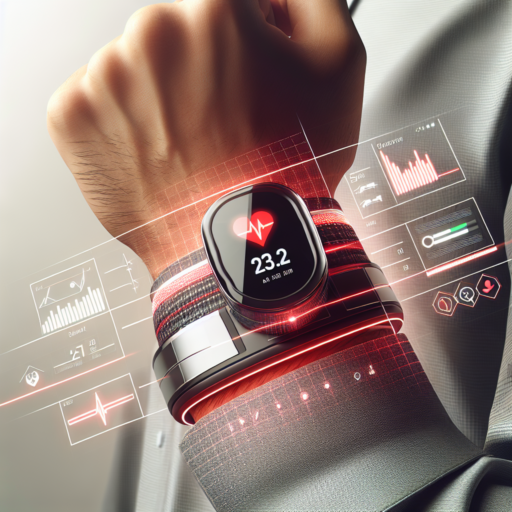What is a Chest Band Heart Rate Monitor?
A chest band heart rate monitor is a device designed to accurately track your heart rate during various physical activities and exercises. Worn around the chest, right below the breastplate, it measures the electrical activity of the heart through sensors that touch the skin. This type of monitor is celebrated for its precision and reliability, making it a favorite among athletes and fitness enthusiasts who aim to optimize their performance and workout efficiency.
Unlike wrist-worn or other types of heart rate monitors, the chest band version ensures minimal signal interference and a snug fit, providing real-time data with remarkable accuracy. This is due to its proximity to the heart and its method of detecting the heart’s electrical signals, which is similar to that of an electrocardiogram (ECG). By offering a continuous and instant readout of heartbeats, users can adjust their workout intensity in the moment, ensuring they stay within their optimal heart rate zones for fat burning, endurance training, or cardiovascular improvement.
The utility of a chest band heart rate monitor extends beyond just workout optimization. It plays a critical role in heart rate training programs, helping athletes monitor their resting and active heart rates and analyze their recovery time. This data is invaluable for designing training regimens that improve overall cardiovascular fitness, efficiency, and performance. Moreover, many modern chest band monitors can connect to smartphones and fitness apps, allowing users to track their progress over time, set fitness goals, and share their achievements through social networks.
How Does a Chest Band Heart Rate Monitor Work?
Chest band heart rate monitors are a popular choice for athletes and fitness enthusiasts looking to track their cardiovascular performance accurately. At their core, these devices operate by detecting electrical signals generated by the heart’s activity. But how do they translate these signals into readable heart rate data? It involves a blend of biophysical principles and technological advancement.
Firstly, when the heart beats, it sends an electrical impulse across the chest. This process is known as cardiac depolarization, leading to the contraction of the heart muscles and thus a heartbeat. The chest band heart rate monitor comes equipped with electrodes that are in direct contact with the skin. These electrodes are highly sensitive and capable of picking up the heart’s electrical signals through the skin. Once detected, these signals are then transmitted to a receiver – typically a watch, a smartphone app, or a fitness device – where the data is displayed.
Signal Processing and Data Interpretation
The magic lies within the signal processing capability of the chest band heart rate monitor. After capturing the electrical activity, the device applies algorithms to filter out noise and accurately identify the unique peaks associated with each heartbeat. This is crucial, as the body generates a vast amount of electrical ‘noise’ from other muscles and activities. By focusing solely on the heart’s electrical pattern, the chest band provides a remarkably accurate measurement of heart rate. Moreover, the direct and consistent contact with the skin ensures that chest band monitors are less likely to lose signal or give inaccurate readings compared to other types of heart rate monitors, making them a reliable tool for precise heart rate tracking.
Benefits of Using a Chest Band Heart Rate Monitor
Monitoring your heart rate during workouts can significantly enhance your training effectiveness, and using a chest band heart rate monitor is one of the most precise methods available. Unlike wrist-based models, chest band heart rate monitors are known for their accuracy and reliability. They capture heart rate data directly from your chest, providing real-time, precise heartbeats per minute.
One of the key benefits of using a chest band heart rate monitor is the ability to maintain an optimal training zone. This ensures that you are not overexerting yourself or, conversely, not pushing hard enough. By keeping an eye on your heart rate, you can adjust your intensity level in real-time, maximizing the efficiency of your workouts. Staying within your target heart rate zone fosters better cardiovascular health and more effective calorie burn.
Furthermore, chest band monitors are exceptionally beneficial for individuals focused on specific training goals, such as endurance building or fat loss. They often feature connectivity with other devices, such as smartphones or fitness watches, allowing you to track your progress over time, set goals, and even share your achievements. The compatibility with various apps and devices enriches the training experience, offering insights and analytics that are tailored to your fitness journey.
In conclusion, the convenience and comfort of chest band heart rate monitors have also greatly improved over the years. Modern designs are lightweight, adjustable, and made from materials that minimize skin irritation, making them ideal for long-duration activities. Whether you’re an amateur enthusiast or a seasoned athlete, the benefits of using a chest band heart rate monitor are clear, ranging from improved accuracy to enhanced training performance.
Top 5 Chest Band Heart Rate Monitors in 2023
Discovering the best chest band heart rate monitor that fits your fitness journey in 2023 can be a bit challenging with the plethora of options available. However, certain models stand out due to their accuracy, connectivity, and comfort. These devices are crucial for athletes and fitness enthusiasts aiming to track their heart rate precisely for improved training sessions. Let’s dive into some of the top picks this year.
Firstly, Garmin HRM-Dual is highly regarded for its exceptional battery life and ability to seamlessly connect via ANT+ and Bluetooth. This makes it incredibly versatile for users who switch between devices like smartphones, GPS watches, and bike computers. Secondly, the Wahoo TICKR X offers an impressive memory feature, allowing users to leave their mobile devices behind and sync their data later. It’s not just about heart rate; it also tracks calories burned, helping users meet their fitness goals.
Another notable mention is the Polar H10, known for its top-notch accuracy and waterproof feature, making it ideal for swimmers and triathletes. The CooSpo H6 is an excellent budget-friendly option that doesn’t compromise on performance. Its compatibility with various apps and fitness equipment makes it a great choice for those looking to experience heart rate monitoring without breaking the bank. Last but not least, the MyZone MZ-3 offers a unique feature of providing feedback based on heart rate zones, encouraging users to push their limits healthily.
Choosing the right chest band heart rate monitor in 2023 involves considering what features are most important to you, be it accuracy, compatibility, or extra functionalities. Whether you’re a seasoned athlete or just starting on your fitness journey, monitoring your heart rate is a crucial aspect of optimizing your workouts and understanding your body better.
How to Choose the Right Chest Band Heart Rate Monitor for You
Choosing the right chest band heart rate monitor can be a daunting decision, especially with the plethora of options available on the market today. It’s essential to consider several key factors to ensure you find a device that not only provides accurate data but also fits comfortably during your fitness activities. The journey to finding the perfect match starts here.
Firstly, examine the compatibility of the heart rate monitor with other devices. Many modern chest bands now offer Bluetooth and ANT+ connectivity, enabling seamless integration with smartphones, GPS watches, and even gym equipment. This feature allows you to track your heart rate data across different platforms for a comprehensive analysis of your performance.
Consider Your Fitness Routine
Your chosen chest band heart rate monitor should align with your fitness goals and the intensity of your workouts. For instance, if you’re into high-intensity interval training (HIIT), look for a monitor designed to accurately capture rapid changes in heart rate. Conversely, if endurance training is more your style, prioritize devices known for their long-lasting battery life and water-resistant properties.
Comfort and Fit are paramount when selecting a chest band heart greater monitor. A device that slides down or causes chafing can disrupt your focus and hinder your performance. Look for adjustable straps and soft materials that accommodate your body shape and size. Additionally, consider the ease of putting on and removing the device, as this can greatly enhance your overall user experience.
Comparing Chest Band Heart Rate Monitors to Wrist-Based Monitors
When it comes to monitoring heart rate, the method of measurement can significantly impact accuracy, comfort, and convenience. Exploring the differences between chest band heart rate monitors and wrist-based monitors unveils a world of contrasts that cater to varied preferences and requirements of individuals engaging in physical activities and fitness tracking.
Chest band heart rate monitors are known for their exceptional accuracy. They work by detecting electrical signals generated by the heartbeat, closely mirroring the methods used in medical heart rate monitoring devices. This makes them a go-to option for athletes requiring precise data during high-intensity activities. On the other hand, wrist-based monitors offer ease of use and comfort, leveraging optical sensors to measure blood flow. These devices have gained popularity for their convenience, blending seamlessly into the daily lives of users by offering a multitude of features beyond heart rate tracking, such as notifications and activity tracking.
However, the choice between these two types of devices often comes down to the specific needs and lifestyle of the user. Chest band monitors, while providing high accuracy, can sometimes be viewed as cumbersome due to the need for direct skin contact, which may not be ideal for all-day wear. Wrist-based monitors, conversely, might sacrifice a degree of precision for the sake of wearability and multifunctionality. The trade-offs between these devices highlight the importance of considering what aspects of heart rate monitoring are most critical to an individual’s fitness goals and daily routine.
Setting Up Your Chest Band Heart Rate Monitor: A Step-by-Step Guide
Getting started with your chest band heart rate monitor can seem daunting at first, but by following a few simple steps, you can be on your way to tracking your heart rate accurately. This guide will walk you through the process, ensuring your device is set up correctly for optimal performance.
Step 1: Unpack and Inspect Your Device
Firstly, carefully unpack your chest band heart rate monitor and ensure that all components are present and in good condition. Check for the chest strap, the sensor module, and any additional items included by the manufacturer. It’s essential to familiarize yourself with these parts early on to facilitate a smoother setup process.
Step 2: Positioning the Chest Strap Correctly
For your heart rate monitor to function accurately, positioning the chest strap is crucial. The strap should sit snugly below your chest muscles, not too tight or too loose. Ensure that the sensor part of the strap is centered directly under your sternum for optimal heart rate detection. Wetting the electrode areas of the strap can improve connectivity and accuracy.
Step 3: Pairing with Your Device
Once the chest strap is in place, the next step is to pair it with your preferred device, whether it’s a watch, smartphone, or fitness tracker. Many modern heart rate monitors use Bluetooth for connectivity, so ensure your device’s Bluetooth is on and in pairing mode. Follow on-screen prompts to complete the pairing process, which typically involves selecting your heart rate monitor from a list of available devices.
No se han encontrado productos.
Tips for Maintaining Your Chest Band Heart Rate Monitor
Maintaining your chest band heart rate monitor is crucial for ensuring its longevity and accuracy. These vital devices, used by athletes and fitness enthusiasts alike, require regular attention to function at their best. From proper cleaning to timely battery changes, we’ll delve into essential maintenance practices to keep your device in top shape.
Cleaning and Storage
Cleaning your chest band heart rate monitor is pivotal to maintain its functionality. After each use, it’s recommended to detach the sensor from the strap and gently clean it with a damp cloth. Avoid using abrasive cleaners that can damage the sensor. The strap itself can often be machine-washed, but always refer to the manufacturer’s guidelines. For storage, ensure the device is dry and keep it in a cool, dry place away from direct sunlight to prevent degradation of the materials.
Battery Replacement and Handling
Most chest band heart rate monitors use coin cell batteries that need replacing periodically. Consistently check the device’s power level, especially before an important workout or event. When replacing the battery, make sure to handle the device and battery with care, avoiding direct contact with the battery terminals to prevent corrosion. Additionally, remember to recycle used batteries properly to minimize environmental impact.
Adhering to these maintenance tips can significantly extend the life of your chest band heart they never compromise your workout readings. Regular care not only ensures accurate heart rate data but also protects your investment, making it a reliable tool in achieving your fitness goals.
Integrating Your Chest Band Heart Rate Monitor with Fitness Apps
Understanding Compatibility
Before you can effectively integrate your chest band heart rate monitor with a fitness app, it’s crucial to ensure compatibility. Most modern heart rate monitors use Bluetooth or ANT+ to connect to apps, but not all apps may support your specific device. Check the specifications of both your heart rate monitor and your chosen fitness apps to ensure they can communicate with each other. This step is paramount to take full advantage of the features offered by both your device and the app.
Choosing the Right App
There’s a plethora of fitness apps available, each offering unique features. Some apps specialize in certain types of training such as running, cycling, or strength workouts, while others offer a more holistic view of your fitness journey. When integrating your chest band heart rate monitor, look for apps that provide detailed heart rate analytics. These insights can help you train more effectively, ensuring you’re in the right heart rate zone for your fitness goals. Apps that allow customization based on heart rate zones can be particularly beneficial for those focusing on cardiovascular health or endurance training.
Seamless Integration for Enhanced Training
Once you’ve ensured compatibility and chosen an app that meets your training needs, the actual integration process typically involves a simple pairing procedure. Navigate to the settings or devices section within the app and select your chest band heart rate monitor from the list of available devices. A successful connection not only allows real-time heart rate monitoring but also enables the app to collect data on your heart rate variability, resting heart rate, and more. This data is invaluable for tailoring your workouts, monitoring your progress, and adjusting your training plan as necessary. With seamless integration, your chest band heart rate monitor and fitness app become a powerful duo in achieving your fitness goals.
Real User Reviews: The Best Chest Band Heart Rate Monitors on the Market
Choosing the right chest band heart rate monitor can significantly impact your fitness journey. Real user reviews play a crucial role in determining the best options available. These gadgets, worn around the chest, offer accurate heart rate readings, making them invaluable for athletes and fitness enthusiasts alike. Let’s explore what users are saying about the best chest band heart gadgets on the market today.
The Most Accurate and Comfortable Options
According to users, comfort and accuracy are paramount when it comes to selecting a chest band heart rate monitor. Brands like Polar and Garmin lead in this category, with many reviewers highlighting the snug yet comfortable fit that doesn’t disrupt workouts. Accuracy is where these devices shine, with several users noting that the heart rate data closely matches those from medical-grade equipment, providing confidence in the metrics tracked during rigorous exercises.
Longevity and Battery Life
Another critical aspect pointed out in reviews is the longevity and battery life of these monitors. Users appreciate devices that offer long-lasting performance and easy-to-replace batteries. Monitors that can endure the rigors of daily workouts without frequent charges stand out in user testimonials. Durability, coupled with robust battery life, makes for a chest band monitor that offers not just convenience but also reliability over time.
In conclusion, sifting through real user reviews sheds light on the best chest band heart rate monitors available. Comfort, accuracy, and durability are key factors that users highlight, helping potential buyers make informed decisions. Whether it’s for high-intensity interval training, long distance running, or any fitness regimen in between, the right chest band heart rate monitor can elevate your training sessions to new heights.



